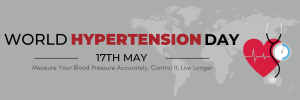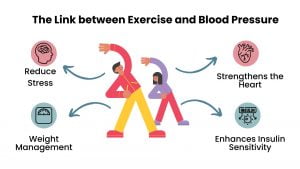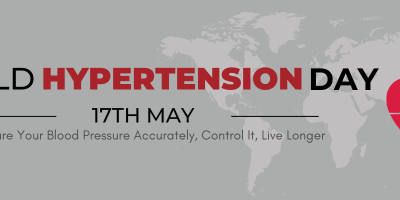
As we mark World Hypertension Day on May 17th, it is crucial to spotlight the silent killer that affects millions worldwide. Hypertension, or high blood pressure, often lurks without symptoms, yet it significantly increases the risk of heart disease, stroke, and other health complications. Despite this concern, exercise offers a glimmer of hope. Physical activity stands as a powerful tool in managing blood pressure and promoting overall health. Let us delve into how exercise can be a game-changer and tips to kickstart your fitness journey.
The Exercise-Blood Pressure Connection:

Strengthens Heart Health:
When you engage in aerobic activities such as brisk walking, jogging, or cycling, your heart works harder to pump oxygen-rich blood to your muscles. Over time, this exercise-induced stress on the heart leads to beneficial adaptations, making it more efficient at pumping blood with each beat. A stronger heart means it can pump more blood with less effort, ultimately lowering your blood pressure.
Weight Management:
Physical activity helps burn calories, leading to weight loss when combined with a balanced diet. Moreover, regular exercise helps maintain weight loss by preserving lean muscle mass and preventing weight regain. By shedding the excess pounds, individuals can significantly reduce their blood pressure and decrease their risk of hypertension-related complications.
Reduces Stress:
Exercise is a natural stress reliever, triggering the release of endorphins, which are chemicals in the brain that promote feelings of well-being and relaxation. Engaging in physical activity provides a healthy outlet for stress and tension, helping to reduce the body’s stress response. At the same time, exercise indirectly contributes to lower blood pressure.
Enhances Insulin Sensitivity:
Poor insulin sensitivity, or insulin resistance, is a precursor to type 2 diabetes and is also linked to hypertension and other cardiovascular risk factors. Exercise improves insulin sensitivity by increasing glucose uptake by muscle cells, thus helping maintain stable blood sugar levels. Ultimately, exercise supports overall metabolic health and reduces the risk of hypertension and related complications.
Tips to Start Exercising:
Set Realistic Goals:
 Begin your fitness journey by setting achievable goals that align with your current fitness level and lifestyle. Whether it is aiming to walk for 30 minutes a day or committing to attending a fitness class twice a week, setting realistic goals sets you up for success and keeps you motivated.
Begin your fitness journey by setting achievable goals that align with your current fitness level and lifestyle. Whether it is aiming to walk for 30 minutes a day or committing to attending a fitness class twice a week, setting realistic goals sets you up for success and keeps you motivated.
Find Activities You Enjoy:
 Exercise does not have to be a chore, it can be enjoyable and even fun! Explore different types of physical activities until you find something that resonates with you. Whether it is dancing, swimming, hiking, or playing a sport, choosing activities you genuinely enjoy increases the likelihood that you will stick with them in the long run.
Exercise does not have to be a chore, it can be enjoyable and even fun! Explore different types of physical activities until you find something that resonates with you. Whether it is dancing, swimming, hiking, or playing a sport, choosing activities you genuinely enjoy increases the likelihood that you will stick with them in the long run.
Mix It Up:
 Variety is key to preventing boredom and avoiding plateaus in your fitness journey. Incorporate a mix of aerobic, strength, and flexibility exercises into your routine to target different muscle groups and aspects of fitness. Not only does mixing up your workouts keep things interesting, but it also ensures that you are challenging your body in different ways for optimal results.
Variety is key to preventing boredom and avoiding plateaus in your fitness journey. Incorporate a mix of aerobic, strength, and flexibility exercises into your routine to target different muscle groups and aspects of fitness. Not only does mixing up your workouts keep things interesting, but it also ensures that you are challenging your body in different ways for optimal results.
Listen to Your Body:
 Pay attention to how your body responds to exercise and adjust your routine accordingly. If you are feeling tired or experiencing pain or discomfort, listening to these signals and giving your body the rest it needs is essential. Pushing through pain or fatigue can lead to injury and derail your progress, so always prioritize your health and well-being.
Pay attention to how your body responds to exercise and adjust your routine accordingly. If you are feeling tired or experiencing pain or discomfort, listening to these signals and giving your body the rest it needs is essential. Pushing through pain or fatigue can lead to injury and derail your progress, so always prioritize your health and well-being.
Buddy Up:
 Exercise with a friend or family member to make workouts more enjoyable and as a way to hold each other accountable. Having a workout buddy provides motivation, support, and companionship, making it easier to stick to your exercise routine. Whether it is going for a walk together, joining a fitness class, or simply checking in with each other regularly.
Exercise with a friend or family member to make workouts more enjoyable and as a way to hold each other accountable. Having a workout buddy provides motivation, support, and companionship, making it easier to stick to your exercise routine. Whether it is going for a walk together, joining a fitness class, or simply checking in with each other regularly.
On World Hypertension Day, let us recognize the power of regular exercise in combating hypertension and promoting heart health. Aim for at least 150 minutes of moderate aerobic activity or 75 minutes of vigorous aerobic activity each week, with 30 minutes most days. Even small lifestyle changes can yield significant benefits. Lace up your shoes, hit the pavement, and embark on the journey to better cardiovascular health today!
References:
- American Heart Association. (2023, June 5). Getting active to control high blood pressure. Www.heart.org. https://www.heart.org/en/health-topics/high-blood-pressure/changes-you-can-make-to-manage-high-blood-pressure/getting-active-to-control-high-blood-pressure
- Mayo Clinic. (2022, November 10). Why exercise is medicine for high blood pressure. Mayo Clinic. https://www.mayoclinic.org/diseases-conditions/high-blood-pressure/in-depth/high-blood-pressure/art-20045206#:~:text=Regular%20exercise%20makes%20the%20heart













